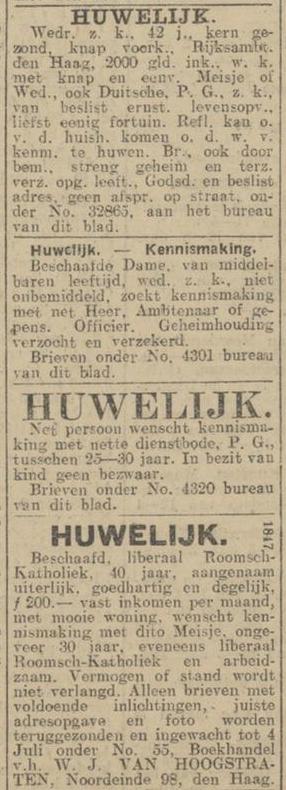Not everyone finds a suitable partner while on holiday, at work, at a club or at the pub. Or on any other occasion where you meet people. Sometimes love needs a helping hand. Today, there are countless dating apps, but before they came available, those looking for a partner had to put an ad in the newspaper. And for a very long time, marriage was the only topic of those ads, as unmarried cohabitation was rare (and frowned upon). Later, the somewhat broader term “contact ad” came into vogue.
I delved into the online archive of Dutch newspapers to see what was wanted and offered over the years.
Income or wealth
In marriage ads placed before World War II, money often played an important role in the choice of partner. In 1921, a widower seeking a young woman or widow placed an ad in the Haagsche Courant. He immediately mentioned his income of Dfl 2,000, and went on to state that he was looking for a woman with ‘preferably some fortune’. In the same issue, a ‘civilised middle-aged lady, not impecunious’ presented herself as a potential marriage partner. In another ad, a 40-year-old man boasted that he earned Dfl 200.= a month, but was sympathetic enough to add: ‘no wealth or position is desired’.
I saw advertisements from 1936 with indications like ‘single young lady of good family with comfortable home seeks acquaintance with wealthy gentleman.’ And also: ‘lady with fixed income wishes to meet ditto gentleman, preferably civil servant or military’. At the time, these were professions you could hardly be fired from, if at all, so this lady really needed permanence. Don’t forget that the 1930s were the years of the Great Depression and a time of massive unemployment.
Religion
Before the war religion was also an important feature of marriage ads. You can see that in designations like: ‘Dutch Reformed’ and ‘Roman Catholic’. Such specifications were necessary only when people advertised in general newspapers. If you advertised in a Catholic or Protestant-Christian newspaper, it could be assumed that you were looking for a like-minded man or woman.
The same goes for the ads in the New Israelite Weekly, the Jewish periodical. But here I noticed something I did not find in other newspapers. It was the word “shadjen”, meaning ‘matchmaker, marriage negotiator, someone who is engaged in initiating and conducting marriage negotiations’. For example: ‘no shadjen’. Or just ‘shadjen wanted’ or ‘shadjen with years of experience offers mediation’. The last time I found this term was in an advertisement in 1967: ‘Wanted: shadjen, known in very good circles’.
Child no obstacle
Nowadays, it is common for one or both of the prospective partners to already have children from a previous relationship. Before the war, divorces were much less common, but there were widows or widowers with children. In 1921, for example, a widow was keen to ‘remarry for herself and her young children’. Apparently, she must have had no trouble finding someone, because when searching on the indication ‘child no obstacle’, I found more than 30,000 ads in over 100 years of newspaper archives. Incidentally, I also saw this phrase in advertisements seeking housekeepers for motherless families. There was of course a practical reason behind those ads, but it will also have happened that the man of the house ended up marrying the housekeeper. So perhaps these were disguised marriage ads.
Appearances and hobbies
In a modern dating app, photos are very important. Contact and marriage ads in newspapers did not offer the option of including a photo. For a very long time, looks didn’t seem important; at least I didn’t see any mentions in the texts. There are, however, indications like ‘respectable’ and ‘decent’. You might call that inner beauty. After the war, texts like ‘nice or sharp appearance’ began to appear. Or ‘blonde’ and ‘slim’. Fortunately, not every man was looking for a woman with mannequin measurements; I’m assuming that ‘well-rounded’ referred to the type of woman seen in paintings by Rubens.
Also, in the 50s and 60s, advertisers more often mentioned their hobbies or leisure activities.
Development
In the 1970s, the number of advertisements in newspapers increased, still under the heading ‘marriage’. They became more elaborate: height, physical descriptions, education, interests, it’s all there.
In the 1980s, in The Netherlands this newspaper section began to be called ‘marriage and acquaintance’; a marriage certificate was no longer the sole objective. And texts became increasingly explicit: ‘sexual young man, seeks sexual woman’ or ‘bisexual man seeks contact with bisexual man or couple’.
Ten years later, in the early 1990s, the section was called ‘marriage, acquaintance etc’ and the variety of supply and demand and the number of ads increased even further. “No smoking” pops up for the first time, reminding me immediately of the expression ‘kissing a smoker is like licking an ashtray’, so I can appreciate this requirement in these ads.
Long-term relationships
Among all the varieties of contact sought, one did appear to be very constant. Many people explicitly said they were looking for a long-term relationship, rather than marriage. However, the list of requirements and characteristics people drew up became longer and longer.
As the title of this article, I have chosen ‘along this unsympathetic road’. This is wording that could be found in many matrimonial ads and sounded like an apology. As if the seeker was ashamed of failing to find someone through the ‘normal’ ways.
The marriage and contact section has all but disappeared from newspapers; in this area too, we live in a digital world. But the search for a partner or contact remains, and it’s my impression that these days it is quite common to tell people you are actively looking for a date or partner.





